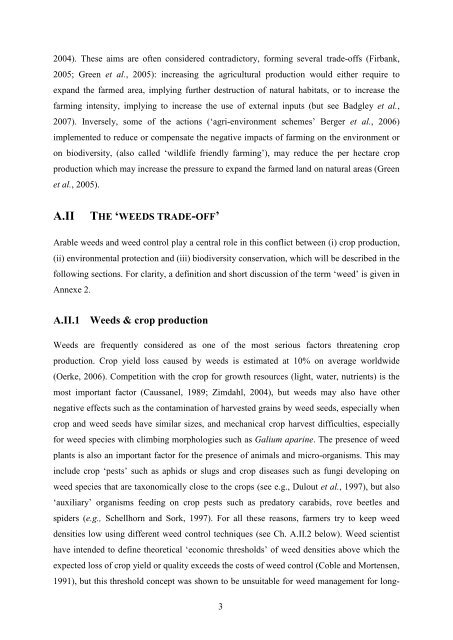Diversifying crop rotations with temporary grasslands - Université de ...
Diversifying crop rotations with temporary grasslands - Université de ...
Diversifying crop rotations with temporary grasslands - Université de ...
You also want an ePaper? Increase the reach of your titles
YUMPU automatically turns print PDFs into web optimized ePapers that Google loves.
2004). These aims are often consi<strong>de</strong>red contradictory, forming several tra<strong>de</strong>-offs (Firbank,<br />
2005; Green et al., 2005): increasing the agricultural production would either require to<br />
expand the farmed area, implying further <strong>de</strong>struction of natural habitats, or to increase the<br />
farming intensity, implying to increase the use of external inputs (but see Badgley et al.,<br />
2007). Inversely, some of the actions (‘agri-environment schemes’ Berger et al., 2006)<br />
implemented to reduce or compensate the negative impacts of farming on the environment or<br />
on biodiversity, (also called ‘wildlife friendly farming’), may reduce the per hectare <strong>crop</strong><br />
production which may increase the pressure to expand the farmed land on natural areas (Green<br />
et al., 2005).<br />
A.II THE ‘WEEDS TRADE-OFF’<br />
Arable weeds and weed control play a central role in this conflict between (i) <strong>crop</strong> production,<br />
(ii) environmental protection and (iii) biodiversity conservation, which will be <strong>de</strong>scribed in the<br />
following sections. For clarity, a <strong>de</strong>finition and short discussion of the term ‘weed’ is given in<br />
Annexe 2.<br />
A.II.1 Weeds & <strong>crop</strong> production<br />
Weeds are frequently consi<strong>de</strong>red as one of the most serious factors threatening <strong>crop</strong><br />
production. Crop yield loss caused by weeds is estimated at 10% on average worldwi<strong>de</strong><br />
(Oerke, 2006). Competition <strong>with</strong> the <strong>crop</strong> for growth resources (light, water, nutrients) is the<br />
most important factor (Caussanel, 1989; Zimdahl, 2004), but weeds may also have other<br />
negative effects such as the contamination of harvested grains by weed seeds, especially when<br />
<strong>crop</strong> and weed seeds have similar sizes, and mechanical <strong>crop</strong> harvest difficulties, especially<br />
for weed species <strong>with</strong> climbing morphologies such as Galium aparine. The presence of weed<br />
plants is also an important factor for the presence of animals and micro-organisms. This may<br />
inclu<strong>de</strong> <strong>crop</strong> ‘pests’ such as aphids or slugs and <strong>crop</strong> diseases such as fungi <strong>de</strong>veloping on<br />
weed species that are taxonomically close to the <strong>crop</strong>s (see e.g., Dulout et al., 1997), but also<br />
‘auxiliary’ organisms feeding on <strong>crop</strong> pests such as predatory carabids, rove beetles and<br />
spi<strong>de</strong>rs (e.g., Schellhorn and Sork, 1997). For all these reasons, farmers try to keep weed<br />
<strong>de</strong>nsities low using different weed control techniques (see Ch. A.II.2 below). Weed scientist<br />
have inten<strong>de</strong>d to <strong>de</strong>fine theoretical ‘economic thresholds’ of weed <strong>de</strong>nsities above which the<br />
expected loss of <strong>crop</strong> yield or quality exceeds the costs of weed control (Coble and Mortensen,<br />
1991), but this threshold concept was shown to be unsuitable for weed management for long-<br />
3

















